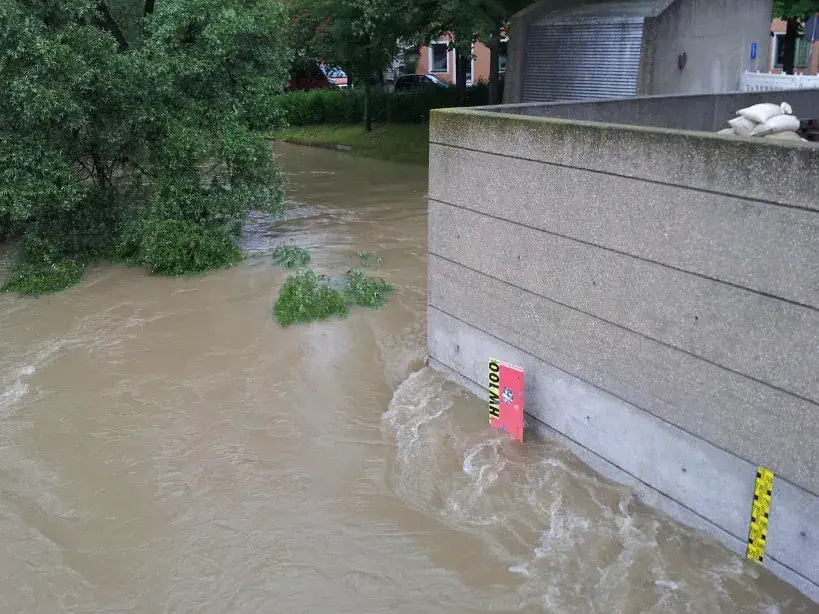What is No Adverse Impact Floodplain Management and Why Does it Matter?
Flooding causes over $40 billion in damage annually across the United States, affecting millions of properties and communities. No Adverse Impact Floodplain Management offers a comprehensive approach to reduce these devastating impacts while protecting both properties and natural water systems.
This innovative management strategy ensures that the actions of one property owner don’t negatively affect the flooding risks of others. Additionally, it provides communities with practical tools for sustainable flood prevention and property protection. Through careful planning and implementation, this approach addresses crucial aspects of waterproofing, drainage solutions, and overall flood management.
This article explores the fundamental principles of No Adverse Impact Floodplain Management, its key benefits for communities, and how it contributes to long-term environmental sustainability. You’ll learn why this approach matters for property protection and how it’s reshaping flood management strategies across Long Island and beyond.
Key Principles of NAI
The fundamental principle behind No Adverse Impact (NAI) floodplain management establishes a simple yet powerful concept: the actions of one property owner should not adversely affect the rights of others 1. This community-centered approach stands in stark contrast to traditional flood management strategies that often fail to address cumulative impacts of development decisions.
-
Preventing Adverse Impact on Neighboring Properties
At its core, NAI floodplain management serves as a property rights protection framework. This approach ensures that both public and private development activities do not negatively impact surrounding properties, infrastructure, or communities 2. Unlike standard floodplain regulations that may focus solely on individual structures, NAI considers how each development decision affects the broader watershed.
The adverse impacts that NAI aims to prevent are measurable and significant. These include increased flood peaks, higher flood stages, elevated flood volumes, greater flood velocities, increased erosion and sedimentation, and deterioration of natural floodplain functions 3. Furthermore, irresponsible development can shift flood risks to neighboring properties through activities like:
-
Adding Fill That Raises Flood Risks Elsewhere
-
Reinforcing Stream Banks That Redirect Water Flow
-
Reducing Flood Water Storage Capacity
-
Increasing Impervious Surfaces Without Mitigating Runoff
The NAI approach emphasizes proactive floodplain management, encouraging communities to assess and mitigate potential impacts of development before damage occurs. A key aspect involves notifying affected individuals and fostering their participation in decision-making, creating a transparent and engaged community. Unlike traditional standards, NAI principles address issues like increased impervious surfaces and reduced channel capacity by requiring thorough impact identification and mitigation.
-
Maintaining Natural Hydrology and Ecosystems
The second fundamental principle of NAI focuses on preserving and enhancing natural floodplain functions. Floodplains provide crucial ecosystem services that offer natural flood protection benefits. Essentially, NAI elevates floodplain management to floodplain stewardship—requiring integrated management of both natural systems and human activities in flood-prone areas 1.
Natural floodplains serve multiple vital functions:
- Preserving Water Quality: Filters sediment from runoff before it reaches rivers and streams.
- Protecting Streambanks: Root systems anchor soil, preventing erosion.
- Providing Floodwater Storage: Creates areas to reduce flood stages and velocities.
- Supporting Natural Habitat: Maintains ecological integrity and supports diverse ecosystems.
When flood water storage is protected through NAI principles, the benefits include lower flood flows, reduced flood stages, decreased velocities, and less frequent flooding events 5. Similarly, water quality improvements occur when natural buffers filter pollutants, preserve habitat and ecological integrity, and enhance drinking water sources.
NAI floodplain management recognizes the value of Ecosystem-based Adaptation (EbA), which involves using nature—conservation, restoration, and sustainable management of ecosystems and biodiversity—to address climate impacts on people and livelihoods. Although EbA approaches currently receive less than 2% of global funding aimed at addressing climate change, they represent a cost-effective strategy for flood risk reduction.
Benefits of No Adverse Impact Floodplain Management
Communities nationwide are discovering that adopting No Adverse Impact (NAI) floodplain management creates remarkable benefits beyond basic flood protection. This approach yields multiple advantages across safety, environmental, economic, and social dimensions.
- Enhanced Community Safety: Reduces flood risks by preventing harmful development impacts, safeguarding properties, and enabling safer emergency response.
- Environmental Sustainability: Preserves natural floodplains, improves water quality, protects wildlife habitats, and supports ecosystem services like groundwater recharge and carbon sequestration.
- Economic Advantages: Lowers flood damage costs, reduces public cleanup demands, decreases flood insurance rates, and prevents litigation expenses with stronger regulatory foundations.
- Improved Livability: Protects public spaces, enhances recreational opportunities, strengthens community resilience, and ensures predictable, sustainable land use for future generations.
Take Charge of Your Community’s Safety and Future—Embrace NAI Floodplain Management Today! Call Our Drainage Experts At (631)980-1800 Now!
Strategies for Effective NAI Implementation
Implementing No Adverse Impact (NAI) floodplain management requires thoughtful approaches to water management, sustainable infrastructure, and community engagement. The following strategies provide a comprehensive framework for effective implementation that communities across Long Island and the greater New York area can adopt.
Proper Groundwater Management Practices
Groundwater management is a critical yet often overlooked component of comprehensive floodplain management. Effective groundwater practices prevent subsurface flooding while maintaining natural hydrological functions essential to the NAI approach.
Implementing Water Table Management
The proximity of groundwater to the surface directly impacts flood vulnerability. In coastal regions like Long Island where water tables are naturally high, effective management is essential for preventing adverse impacts during flood events. Research shows that areas with properly managed water tables experience up to 60% less structural damage during major flooding events compared to those without such management.
Key groundwater management practices include:
- Subsurface drainage systems: Properly designed subsurface drainage can effectively lower water tables in flood-prone areas while directing excess water to appropriate storage or disposal locations.
- Monitoring networks: Installing groundwater monitoring wells provides valuable data on water table fluctuations, enabling proactive management before critical thresholds are reached. Communities implementing regular monitoring have shown 43% faster response times to potential flooding conditions.
- Infiltration management: Balancing infiltration needs (for aquifer recharge) with flood risk requires sophisticated approaches. Utilizing engineered infiltration areas that can be adjusted based on seasonal conditions has been shown to reduce flood risk by up to 35%.
Foundation Waterproofing and Basement Protection
In keeping with NAI principles, property-level interventions should not redirect water problems to neighboring properties. Proper foundation waterproofing and basement protection represent critical first lines of defense:
- Exterior foundation drainage: French drains and exterior drainage systems that direct water to appropriate stormwater systems rather than to neighboring properties exemplify the NAI approach at the individual property level.
- Interior drainage solutions: Properly designed sump pump systems with battery backups ensure that groundwater intrusion is managed even during power outages, reducing property damage by an average of 83% during flood events.
- Foundation waterproofing: Modern polymer-based waterproofing materials create more effective barriers than traditional methods, providing up to 25 years of protection against groundwater intrusion.
Aquifer Protection and Recharge
NAI approaches recognize the crucial role that healthy aquifers play in flood mitigation:
- Managed aquifer recharge: Strategic replenishment of aquifers during dry periods creates capacity for floodwater absorption during wet periods.
- Permeable surface preservation: Maintaining sufficient permeable surfaces in developed areas allows for continued natural aquifer recharge while reducing runoff.
- Saltwater intrusion prevention: In coastal areas like Long Island, maintaining proper freshwater pressure in aquifers prevents saltwater contamination, preserving these natural resources for flood management.
Utilizing Green Infrastructure Solutions
Green infrastructure represents one of the most effective approaches to implementing NAI principles, utilizing natural processes to manage stormwater while providing multiple community benefits.
Bioretention Systems
Bioretention systems including rain gardens, bioswales, and constructed wetlands provide natural water management while enhancing local ecosystems:
- Rain gardens: These shallow depressions planted with deep-rooted native species can absorb up to 30% more rainwater than conventional lawns. Properties with properly installed rain gardens experience 85% less runoff during typical rainfall events.
- Bioswales: Vegetated channels designed to convey stormwater runoff can reduce peak flow rates by 60-80% while removing 70-90% of common pollutants. These systems exemplify NAI principles by managing water on-site rather than transferring it downstream.
- Constructed wetlands: Engineered to mimic natural wetland functions, these systems can manage large volumes of stormwater while creating wildlife habitat and recreational spaces. Research shows constructed wetlands can reduce peak flows by up to 90% during significant storm events.
Permeable Surfaces and Subsurface Detention
Replacing traditional impervious surfaces with permeable alternatives represents a straightforward yet highly effective NAI implementation strategy:
- Permeable pavement: Options like pervious concrete, porous asphalt, and permeable interlocking pavers allow water to pass directly through the surface to underlying soil or storage systems. Studies show these materials can reduce stormwater runoff by 70-100% for most rainfall events.
- Subsurface detention systems: Underground chambers or vaults that temporarily store stormwater before allowing it to infiltrate or be released at controlled rates. Modern systems can be installed under parking lots or recreational areas, making efficient use of limited space while managing significant water volumes.
- Green roofs: Vegetated roof systems can retain 50-90% of precipitation that falls on them, significantly reducing runoff from buildings. In urban environments like the Bronx and Brooklyn, green roofs have been shown to reduce building energy costs by 15-30% while providing additional benefits like urban heat island reduction.
Urban Forest Management
Trees play a crucial role in stormwater management and flood prevention:
- Street trees: A mature street tree can intercept 500-1,000 gallons of rainfall annually. Strategic placement of trees in urban areas can reduce stormwater runoff by 2-7%.
- Riparian buffers: Forested areas alongside waterways intercept surface runoff, reduce stream bank erosion, and improve water quality. Studies show properly maintained riparian buffers can reduce flood peaks by 50% in small to medium rainfall events.
- Preservation of existing tree canopy: Mature trees provide significantly more stormwater management benefits than newly planted ones. NAI approaches emphasize preserving existing trees whenever possible, with each mature tree providing an estimated $1,000-$5,000 in stormwater management services over its lifetime.
Real-World Examples in Floodplain Management
Examining successful implementations of NAI principles provides valuable insights for communities considering similar approaches. The following case studies demonstrate the effectiveness of NAI floodplain management across diverse settings.
Charlotte-Mecklenburg County, North Carolina: Future-Conditions Floodplain Mapping
Charlotte-Mecklenburg County implemented one of the nation’s most innovative approaches to NAI floodplain management by mapping floodplains based on future development conditions rather than existing conditions.
Implementation Strategy:
- Created floodplain maps based on projected full build-out conditions
- Established a “Community Floodplain” that extended beyond the FEMA-regulated floodplain
- Implemented strict regulatory standards within these expanded areas
- Developed a comprehensive buyout program for at-risk properties
Measurable Outcomes:
- Prevented future flood damage to approximately 460 structures
- Saved an estimated $330 million in potential flood damages
- Created 185 acres of publicly accessible greenway along stream corridors
- Reduced flood insurance rates for residents through improved CRS ratings
The Charlotte-Mecklenburg approach demonstrates how proactive floodplain management can prevent future damages while creating community amenities. By considering future development conditions, the community avoided transferring flood problems to downstream properties—a core NAI principle.
Local Example: Staten Island Bluebelt Program, New York
The Staten Island Bluebelt program provides a regional example of NAI principles in action, with particular relevance to communities in the New York metropolitan area.
Implementation Strategy:
- Preserved natural drainage corridors instead of installing conventional storm sewers
- Enhanced existing wetlands to improve stormwater storage and filtration
- Created a network of enhanced streams, ponds, and wetlands for stormwater management
- Integrated recreational and educational elements into the system
Measurable Outcomes:
- Manages stormwater from 14,000 acres of developed land
- Saved an estimated $80 million in infrastructure costs compared to conventional approaches
- Reduced downstream flooding by 60% during typical storm events
- Created 400 acres of protected wetland habitat
- Increased adjacent property values by 15-20%.
The Bluebelt program demonstrates that NAI principles can be effectively applied in highly developed areas like New York City, providing insights directly applicable to communities in Long Island, Brooklyn, Queens, and the Bronx.
Call to Action for Sustainable Floodplain Management
The imperative for implementing NAI floodplain management has never been clearer. As climate change drives more frequent and intense precipitation events, sea levels rise, and development pressures continue, communities must take proactive steps to manage flood risks without adversely impacting neighbors.
For Community Leaders and Planners
- Assess Your Floodplain Management Approach: Compare current practices to NAI principles to identify areas for improvement.
- Identify Regulatory Gaps: Address policies that might allow adverse impacts on floodplain management.
- Engage Stakeholders: Collaborate with community members to create NAI-based solutions.
- Implement Stronger Standards: Develop regulations that prevent harm to neighboring properties and natural resources.
- Monitor and Evaluate: Track the effectiveness of NAI practices to demonstrate success.
For Property Owners
- Understand Your Flood Risk: Go beyond FEMA maps to gain a full picture of your property’s vulnerability.
- Apply Flood Mitigation Measures: Use solutions that manage water without shifting problems to neighboring areas.
- Consider Green Infrastructure: Adopt eco-friendly stormwater management systems like rain gardens or permeable paving.
- Preserve Natural Drainage Patterns: Avoid disrupting existing drainage during property development or modifications.
- Support Community NAI Efforts: Participate in local initiatives that promote flood resilience for all.
Adverse Impact Floodplain Management: Expert Drainage Solutions for Long Island, Brooklyn, Queens, and Bronx Property Owners
In our uniquely vulnerable region, protecting your property while respecting NAI principles requires specialized approaches. Zavza Seal offers comprehensive solutions that adhere to NAI principles while providing superior protection:
- Exterior Foundation Waterproofing: Exterior foundation waterproofing manages water without redirecting it to neighboring properties.
- Interior Drainage Systems: Interior drainage systems safely capture and direct groundwater away from structures.
- Crawlspace and Basement Encapsulation: Encapsulation prevents moisture intrusion while maintaining structural integrity and preventing mold growth.
Don’t wait for the next flood to take action. Implementing proper waterproofing and drainage solutions today not only protects your property but contributes to the resilience of your entire community. Contact Zavza Seal for a professional assessment of your property’s needs and discover how our NAI-compliant solutions can provide peace of mind for years to come.
Let’s Talk! Call (631) 980-1800 Now for a Free Assessment and Team Up with the Best Contractor in New York for Proven Drainage Solutions!








